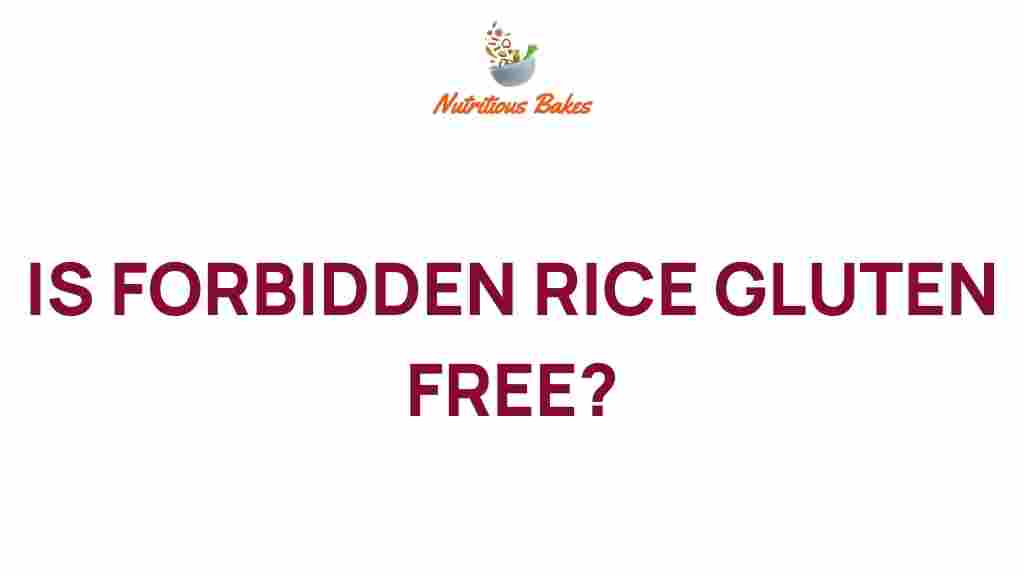Is Forbidden Rice the Gluten-Free Alternative You’ve Been Seeking?
In the ever-evolving world of dietary choices, the search for healthy, gluten-free alternatives has led many health-conscious individuals to discover forbidden rice. Known for its striking black color and rich nutritional profile, forbidden rice is not just a trendy ingredient; it is an ancient grain with a plethora of health benefits. In this article, we will explore the nutritional advantages of forbidden rice, its place in the realm of gluten-free diets, cooking tips, and a selection of delicious recipes to incorporate this superfood into your meals.
The Nutritional Powerhouse: What is Forbidden Rice?
Forbidden rice, also known as black rice, has a fascinating history that dates back centuries. Originally cultivated in China, it was reserved for emperors and the wealthy, hence the name “forbidden.” This ancient grain is now widely available and recognized for its exceptional health benefits.
Health Benefits of Forbidden Rice
Forbidden rice is packed with nutrients that make it an excellent choice for those looking to enhance their diet. Here are some of the key health benefits:
- High in Antioxidants: The deep black color of forbidden rice comes from anthocyanins, powerful antioxidants that can help combat oxidative stress and inflammation in the body.
- Rich in Fiber: As a whole grain, forbidden rice is high in dietary fiber, which aids digestion, helps maintain a healthy weight, and can lower cholesterol levels.
- Gluten-Free: Naturally gluten-free, forbidden rice is an excellent option for those with celiac disease or gluten intolerance.
- Vitamins and Minerals: It contains essential vitamins and minerals, including iron, vitamin E, and various B vitamins, contributing to overall health and wellness.
- Low Glycemic Index: Forbidden rice has a low glycemic index, making it a suitable carbohydrate source for those managing blood sugar levels.
Incorporating Forbidden Rice into Your Gluten-Free Diet
For those seeking to adopt a gluten-free lifestyle, integrating forbidden rice into your meals can be both nutritious and delicious. Here are some cooking tips and recipe ideas to get you started:
Cooking Tips for Forbidden Rice
Cooking forbidden rice is similar to cooking other whole grains, but there are a few specific tips to keep in mind:
- Rinse Before Cooking: Rinse the rice under cold water to remove any excess starch and improve the texture.
- Soaking: Soaking forbidden rice for a few hours or overnight can help reduce cooking time and enhance its digestibility.
- Cooking Ratio: Use a 2:1 ratio of water to rice. Bring the water to a boil, then reduce to a simmer and cover for about 30-40 minutes until tender.
- Resting Time: After cooking, let the rice sit covered for about 10 minutes to allow it to steam and become fluffy.
Delicious Forbidden Rice Recipes
Here are a few recipes that showcase the unique flavor and texture of forbidden rice:
1. Forbidden Rice Salad
Ingredients:
- 1 cup cooked forbidden rice
- 1 cup cherry tomatoes, halved
- 1 cucumber, diced
- 1/4 cup red onion, finely chopped
- 1/4 cup parsley, chopped
- 3 tablespoons olive oil
- 2 tablespoons balsamic vinegar
- Salt and pepper to taste
Instructions:
- In a large bowl, combine the cooked forbidden rice, tomatoes, cucumber, red onion, and parsley.
- In a separate bowl, whisk together the olive oil, balsamic vinegar, salt, and pepper.
- Pour the dressing over the salad and toss gently to combine. Serve chilled or at room temperature.
2. Forbidden Rice Pudding
Ingredients:
- 1 cup cooked forbidden rice
- 2 cups coconut milk
- 1/4 cup maple syrup or honey
- 1 teaspoon vanilla extract
- 1/2 teaspoon cinnamon
- Pinch of salt
Instructions:
- In a saucepan, combine the cooked forbidden rice, coconut milk, maple syrup, vanilla extract, cinnamon, and salt.
- Cook over medium heat, stirring frequently, until the mixture thickens and becomes creamy (about 15-20 minutes).
- Remove from heat and let it cool slightly before serving. Enjoy warm or chilled.
For More Recipes
If you’re looking for further inspiration, check out these other gluten-free recipes that incorporate ancient grains.
Troubleshooting Common Cooking Issues
Cooking forbidden rice can sometimes present challenges. Here are some common issues and tips to troubleshoot them:
- Rice Too Chewy: If your forbidden rice is chewy, it may need more cooking time. Add a little more water and continue cooking until it reaches the desired tenderness.
- Rice Too Sticky: To avoid sticky rice, ensure you rinse it thoroughly before cooking. A little oil can also help prevent sticking.
- Flavor Issues: If the rice tastes bland, consider adding herbs, spices, or a flavorful broth during cooking to enhance its taste.
Conclusion: The Versatile and Nutritious Choice
In conclusion, forbidden rice is an excellent gluten-free alternative that not only adds a unique flavor and color to your dishes but also comes with a wealth of health benefits. Its status as an ancient grain makes it a fantastic addition to modern diets, especially for those seeking nutritious dietary choices. Whether you enjoy it in salads, puddings, or as a side dish, forbidden rice is versatile and easy to incorporate into your meals.
So, if you’re looking to diversify your grain options, give forbidden rice a try. With its impressive nutrition profile and delightful taste, it just might become your new favorite whole grain. Happy cooking!
This article is in the category Ingredients and created by NutritiousBakes Team
